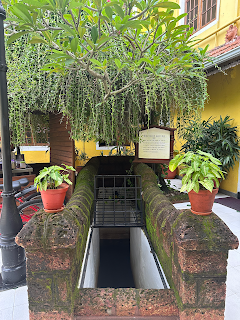Wendall -- every other Thursday
I just found a grape in my bra.
It’s small, dark blue, and intact. I take it out carefully, since it’s fallen down my shirt from the “Mother Vine,” said to be the oldest grapevine in California, and located at the historic San Gabriel Mission on the outskirts of Los Angeles. It was planted almost 250 years ago, long before anyone had thought about touring Napa Valley or Paso Robles.

The root of the "Mother Vine." 
From another angle...
My husband and I spent the morning picking grapes from this astonishing vine with other volunteers assisting the members of LAVA – the LA Vintners Association. The grapes down our clothes, the twigs and stems in our hair, and the purple stains on our fingers were all just part of the fun.

Pruning the Mother Vine! 
James in action.
 | ||||
| Our fellow volunteers and vintners |

Mark Blatty backs his truck in when we run out of ladders.

Sadly, we didn't get to stomp.
And it was nice to know we’d made a tiny contribution to the limited edition “Angelica” wine that comes from these grapes–-especially since the Mission receives part of the proceeds.

They only make 300 bottles of the Angelica. This one, just released last week, is from the harvest we helped with in 2021.
This was the second time we’d brought stepladders and garden shears to help with the harvest. The first time, in 2021, the Mission itself was being restored after a fire.

You can see the scaffolding on the left and fire damage on the right.
Now that’s done, and the church and the grounds are gorgeous and again open to the public.
It’s part of the “California Mission Tour” and also very close to the Huntington Gardens, so if you are seeing the sites of LA, it’s really worth a visit.
Everyone knows about California wines, but few know that the
California wine industry actually started in downtown Los Angeles. In fact, the official seal of the City of LA, designed in 1905, includes a bunch of grapes, due to the many vineyards that flourished here in the 19th century, until a blight, then Prohibition, finished most of them off.
So it's only fitting that Downtown LA and Los Angeles County are now the focus of a whole new generation of devoted vintners who are making history all over again.
LAVA was started by the The Angeleno Wine Company, Cavaletti Vineyards, and Byron Blatty Wines—all lovely people and all remarkably supportive of each other. They source wines from growers in greater Los Angeles County and often from vines that have been neglected for years—including one on the grounds of a high school.
We’ve been to a series of LAVA tastings and have also had lovely afternoons at the AWC winery on North Spring St. in LA and the Cavaletti tasting room in Moorpark.
 | |
| The Angeleno Wine Company winery and tasting room in Downtown LA. |

The Cavaletti Wines tasting room in Moorpark.
We drank the AWC’s Goldline 2022 for Thanksgiving, and always save a bottle of Byron Blatty’s Evenfall for special occasions, like finishing books...

Celebrating getting to the end of Cheap Trills.
It’s wonderful to have wine in our house that’s been made by people we actually know and like, the ultimate “winery to table” experience, and it’s another reason we’re lucky to live in the ever-surprising Los Angeles.



























.JPG)
































































